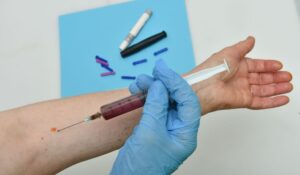Does Mitragynine Show Up on a Drug Test?
Mitragynine is the main alkaloid found in Mitragyna speciosa, also known as kratom. This plant comes from Southeast Asia and has been used for many years to help with pain, mood, and energy. In the United States, people often ask if mitragynine shows up on a drug test, especially in settings like employment, therapy, treatment programs, or recovery centers.
Drug testing is an important part of substance abuse treatment, workplace safety, and mental health care. At Lynk Diagnostics, a trusted drug testing center dedicated to rehab facilities, testing helps patients and providers understand risks and create safe plans for recovery.
This article breaks down how mitragynine, its metabolism, and testing methods work. You’ll learn how urine, blood, saliva, and hair follicle tests may detect it, how it interacts with the body’s opioid receptors, and what it means for addiction, health, and law.
What Is Mitragynine?
Mitragynine is a natural alkaloid found in the leaves of the Mitragyna speciosa tree. It is the most abundant active compound in kratom. Some people use kratom in powder, capsule, or tea form.
- At low doses, mitragynine may act like a stimulant, creating alertness, euphoria, or energy.
- At higher doses, it may act like a sedative or opioid, leading to relaxation, pain relief, or drowsiness.
Because it binds to opioid receptors in the brain, mitragynine can act like an opiate, similar to morphine, codeine, methadone, or hydrocodone.
Why Do People Worry About Drug Tests and Mitragynine?
Many patients, employees, and families ask about mitragynine testing because of:
- Employment testing: Companies may test for controlled substances like opioids, amphetamines, benzodiazepines, or barbiturates.
- Substance abuse programs: People in recovery may be tested to monitor relapse or dual diagnosis treatment.
- Law and health concerns: Some states like Illinois and others have made laws about kratom, while others allow access.
Because kratom is not yet part of standard drug tests, there is confusion about whether mitragynine will appear on urinalysis, saliva tests, or blood tests.
How Mitragynine Works in the Body
After taking mitragynine, the liver metabolizes it into compounds such as 7-hydroxymitragynine, another strong alkaloid. These metabolites spread through the blood, urine, and saliva.
- Metabolism: The liver breaks down kratom alkaloids into metabolites.
- Excretion: These metabolites leave the body through urine, saliva, sweat, and hair growth.
- Potency: Factors like dose, frequency, strain, and health affect how long mitragynine stays in the system.
Does Mitragynine Show Up on a Standard Drug Test?
Most standard drug tests (such as 5-panel or 10-panel urine drug tests) check for:
- Opiates (morphine, codeine)
- Amphetamines (amphetamine, methamphetamine, Adderall)
- Benzodiazepines
- Barbiturates
- Phencyclidine (PCP)
- THC, cocaine, fentanyl, oxycodone, tramadol, methadone (depending on the panel)
Mitragynine is not usually included in these panels. This means that in most workplace or health settings, mitragynine will not show up on a routine test.
Specialized Kratom Testing
Although standard tests may miss it, specialized kratom testing is available. Laboratories may use:
- Urine drug tests (urinalysis): Can detect mitragynine for up to 7 days depending on dose and frequency.
- Blood tests: Can measure active compounds within 24–48 hours of use.
- Saliva drug tests: Less common, but possible for short-term detection.
- Hair follicle tests: May detect alkaloids for up to 90 days or longer.
These advanced methods often use chromatography or mass spectrometry for accuracy.
Factors That Affect Detection
The chance of mitragynine showing up depends on:
- Dose: Larger amounts stay in the body longer.
- Frequency: Daily use builds up more metabolites.
- Strain and potency: Different kratom strains have different alkaloid levels.
- Health and disease: Liver or kidney problems slow metabolism.
- Other substances: Mixing with alcohol, opioids, benzodiazepines, or prescription drug addiction medications can affect results.
Mitragynine and Addiction Risks
Some people use mitragynine for pain management, insomnia, or anxiety, but it may also cause:
- Nausea, vomiting, diarrhea, constipation
- Mood changes, irritability, or anxiety
- Physical dependence and possible relapse after stopping
- Withdrawal symptoms similar to opioids
Because it acts on opioid receptors, mitragynine can lead to addiction and substance abuse.
Treatment and Recovery Support
Patients struggling with kratom use may benefit from:
- Therapy and counseling for mental health
- Medication support for withdrawal
- Dual diagnosis programs for those with anxiety, depression, or other conditions
- Recovery programs that focus on long-term health and relapse prevention
At Lynk Diagnostics, accurate drug testing plays a key role in helping rehab facilities provide the right care.
Legal and Employment Concerns
- Controlled Substances Act: Mitragynine is not federally scheduled, but some states restrict it.
- Employment: Employers can request specialized kratom testing if needed.
- Insurance: Some health or rehab programs may require testing for coverage.
- Law enforcement: Courts and probation programs may add kratom to testing panels.
Health and Safety Considerations
Using mitragynine with other substances like fentanyl, morphine, oxycodone, methamphetamine, psilocybin, or alcohol can increase risks.
Patients with heart disease, liver problems, or mental health conditions may face stronger side effects.
Safe recovery requires laboratory testing, professional therapy, and treatment programs when needed.
FAQs
Does mitragynine show up on a drug test?
Mitragynine does not show up on most standard drug tests, but specialized tests like urine, blood, or hair follicle testing can detect it.
How long does mitragynine stay in your system?
Mitragynine can stay in the body from 24 hours to 7 days, depending on the dose, frequency, metabolism, and health of the patient.
Can mitragynine cause a false positive?
Standard tests rarely detect mitragynine, but in rare cases, it could be confused with opioids or other alkaloids if the lab uses broad panels.
Why would someone test for mitragynine?
Testing may be required for employment, rehab programs, dual diagnosis treatment, or legal cases. Specialized labs may include it in their panels.
Is mitragynine safe to use?
While some use it for pain or mood, it can cause addiction, health problems, and withdrawal. Medical supervision is important for treatment and recovery.
Final Thoughts
So, does mitragynine show up on a drug test? The answer depends on the type of test. Standard urine drug tests usually do not detect it, but specialized laboratory testing can.
For those in substance abuse treatment, pain management, or recovery programs, understanding how mitragynine works in the body is key. With the help of Lynk Diagnostics and rehab facilities, patients can move toward safe recovery and better mental health.








